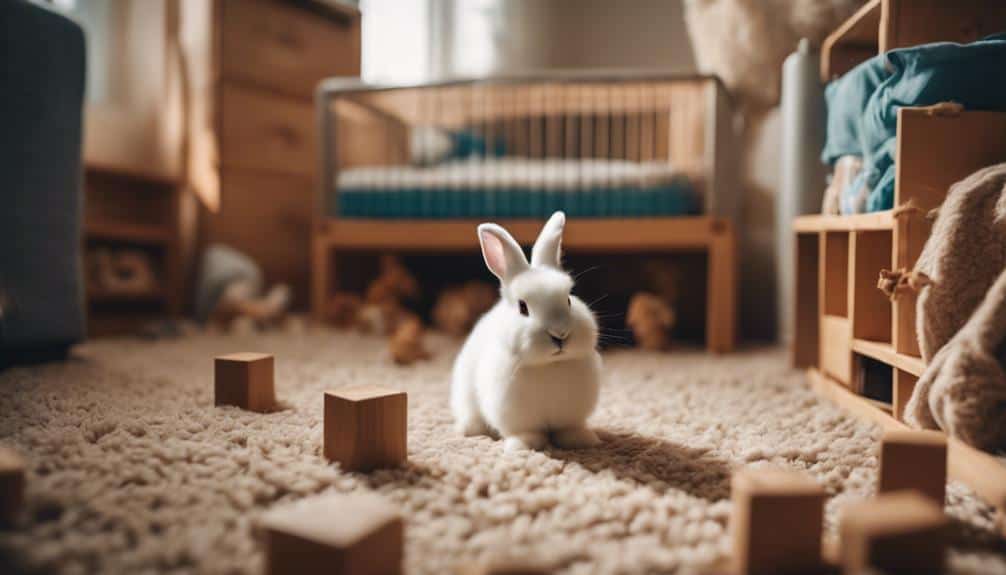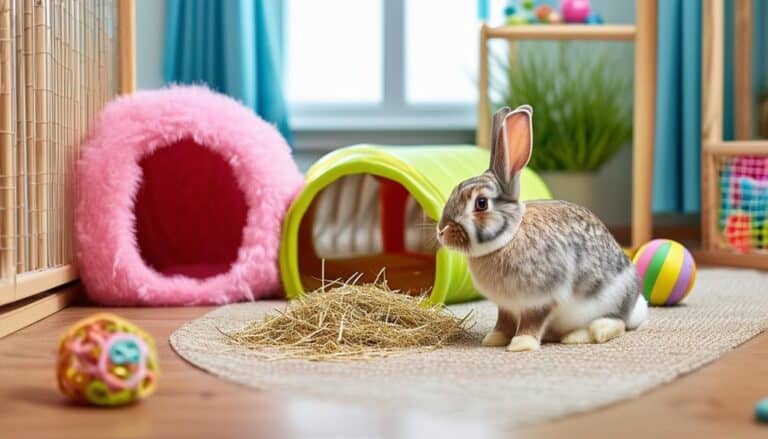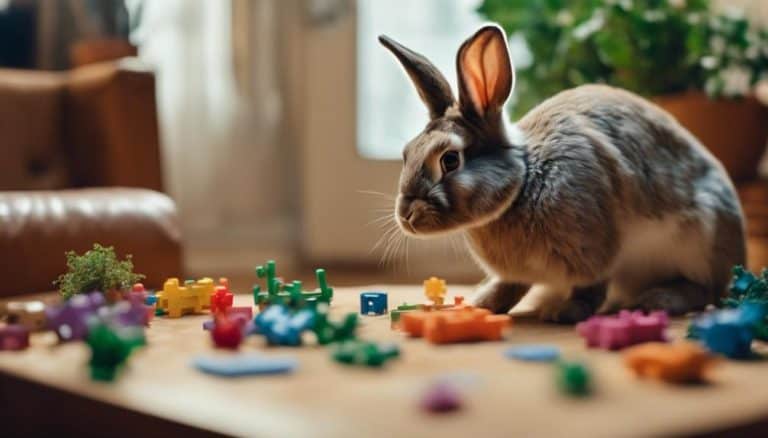How to Prevent Your Pet Rabbit From Digging
If you’re dealing with a pet rabbit that loves to dig, you’re not alone; it’s a natural behavior that can become a bit of a nuisance. But don’t worry, there are effective strategies to manage this.
Instead of simply scolding your rabbit, focus on understanding why they dig and how to redirect this instinct in a constructive way. One key approach involves creating a special digging area with appropriate materials.
This isn’t just about controlling behavior but also about ensuring your rabbit’s mental and physical well-being. Curious about how to set this up and what other methods can help?
Understanding Rabbit Digging
Rabbits dig for various reasons such as constructing burrows, seeking food, regulating their body temperature, escaping threats, and gaining attention. Understanding rabbit digging is vital for providing an environment that respects these natural behaviors while mitigating unwanted digging.
This instinctive behavior is deeply ingrained, and female rabbits typically build large burrows for nesting, whereas males create scrapes for marking their territory.
Providing a designated digging area, such as a digging box filled with suitable substrates like soil, sand, or shredded paper, can cater to a rabbit’s natural behavior. This controlled environment allows them to exercise their muscles and maintain overall well-being without causing damage to your home.
To further support their instinctive need to dig, supervised outdoor time in a safe, enclosed environment can be beneficial. This not only fulfills their digging instinct but also provides mental stimulation and physical exercise.
Reasons Behind Digging
Understanding why your rabbit digs can help you address this behavior effectively. Digging is an essential act that rabbits perform for several reasons.
To begin with, rabbits dig to construct burrows, which serve as their shelters in the wild. These burrows provide safety and comfort. Female rabbits are particularly inclined to create large burrows, a behavior related to nesting.
Another reason behind digging is the search for food. In nature, rabbits dig to uncover hidden food sources. Additionally, they might dig to expose cool earth, helping them regulate their body temperature during warm weather.
Digging can also be an escape tactic. A rabbit might dig to create an exit route if it feels trapped or threatened.
Moreover, males often dig scrapes to mark their territory. This territorial behavior indicates a natural instinct to communicate dominance and ownership.
Beyond these specific purposes, digging is vital for your rabbit’s physical health. It promotes muscle use and fulfills important welfare needs.
Addressing your rabbit’s digging behavior requires understanding these natural instincts. By recognizing these underlying reasons, you’ll be better equipped to manage and mitigate unwanted digging effectively while respecting your rabbit’s natural tendencies.
Providing Digging Alternatives
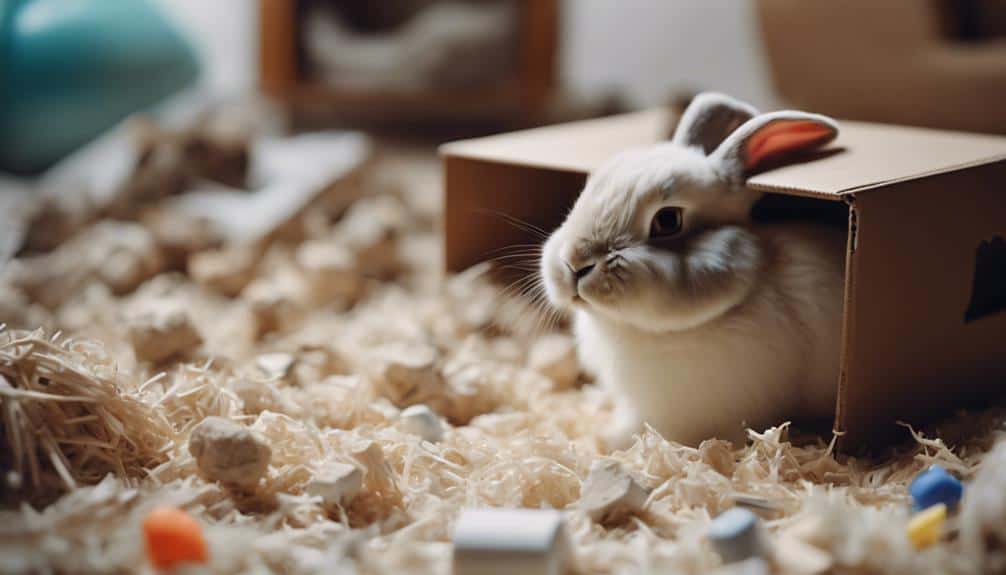
To mitigate your rabbit’s digging behavior, you can establish indoor digging boxes filled with substrates like hay or shredded paper.
Designate outdoor digging areas using untreated grass mats or soil patches.
Incorporate enrichment toys and activities to keep your rabbit engaged and redirect their natural digging instincts effectively.
Indoor Digging Boxes
Creating indoor digging boxes filled with crumbly soil, sand, or shredded paper is an effective way to redirect your rabbit’s natural digging behavior. By providing a designated area for your rabbit to dig, you can greatly reduce instances of destructive behavior in other parts of your home. Indoor digging boxes aren’t only a practical solution but also cater to the mental and physical needs of your rabbit, enhancing their overall well-being.
Here are the key elements to take into account when setting up indoor digging boxes:
- Material Selection: Use crumbly soil, sand, or shredded paper to mimic natural digging substrates.
- Box Size: Make sure the box is large enough for your rabbit to comfortably dig and move around in.
- Supervision: Monitor your rabbit during digging sessions to prevent ingestion of inappropriate materials.
- Location: Place the digging box in a quiet, low-traffic area to encourage consistent use.
Encouraging supervised digging time in these designated areas can help alleviate stress-related behaviors and maintain a harmonious indoor environment. Evidence suggests that providing appropriate outlets for a rabbit’s digging behavior can improve their welfare and prevent stress-induced actions.
Outdoor Digging Areas
Establishing designated outdoor digging areas with loose soil or sand effectively channels your rabbit’s natural digging instincts in a controlled and safe environment. By creating these spaces, you provide an opportunity for your rabbit to engage in natural behaviors without the risk of damage to your garden or escape attempts.
To set up an outdoor digging area, choose a section of your yard and fill it with loose soil or sand. This specific substrate mimics a rabbit’s natural habitat, encouraging them to dig in an appropriate location. You can also provide a digging box filled with hay or litter as an additional option within the designated area.
Supervised outdoor time is essential to guarantee your rabbit’s safety. Use wire barriers around the digging area to prevent escape while allowing your rabbit to exercise and fulfill their digging needs. Regularly inspect these barriers for any signs of wear or potential escape routes.
Offering these structured outdoor digging areas not only helps redirect your rabbit’s digging instincts but also contributes to their overall well-being. By providing safe and controlled environments, you meet their behavioral needs while maintaining the integrity of your outdoor space.
Enrichment Toys & Activities
How can you effectively curb your rabbit’s digging tendencies while promoting mental and physical stimulation? The key lies in providing engaging enrichment toys and activities. By offering alternatives like digging boxes filled with hay or shredded paper, you can redirect your rabbit’s natural digging behavior into a controlled environment. These alternatives not only prevent destructive habits but also offer essential mental stimulation.
Consider incorporating the following enrichment items:
- Digging Boxes: Fill these with hay, shredded paper, or untreated grass mats to mimic natural foraging and digging experiences.
- Foraging Mats: These mats encourage your rabbit to search for hidden treats, keeping them occupied and mentally stimulated.
- Tunnels and Hideouts: Providing spaces for exploration can reduce the urge to dig in unwanted areas.
- Untreated Grass Mats: Place these in their play area to satisfy digging instincts and prevent boredom.
Hiding treats or toys in the digging boxes encourages further exploration and engagement. Ensuring easy access to these alternatives can notably reduce unwanted digging behaviors.
Creating a Digging Box
A digging box serves as an effective solution for managing your rabbit’s natural digging instincts by providing a designated space filled with suitable materials like hay, shredded paper, or crumbly soil. To create an ideal digging box, you should fill it with these materials, which encourage your rabbit to engage in this instinctive behavior in a controlled environment. This method not only satisfies your rabbit’s innate need to dig but also protects your home from unwanted digging damage.
Position the digging box in a key and safe spot where your rabbit feels secure. This location is essential for ensuring your rabbit’s comfort and willingness to use the box consistently. You can further enhance the digging box’s appeal by occasionally hiding treats or toys within the materials. This tactic stimulates your rabbit’s curiosity and provides additional motivation to dig within the designated area.
Regularly engaging your rabbit in the digging box can effectively redirect its digging behavior away from undesirable areas, promoting a harmonious living environment. By implementing a well-constructed digging box, you address your rabbit’s behavioral needs while preserving the integrity of your home space.
Using Mats and Toys
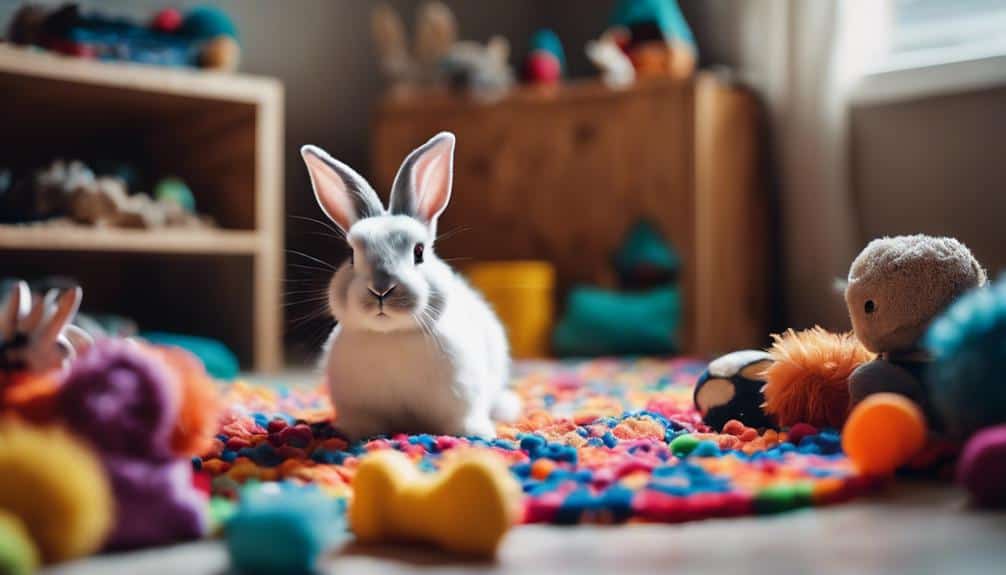
Incorporating textured mats and engaging toys into your rabbit’s environment can effectively deter inappropriate digging behaviors by providing alternative outlets for their natural instincts. Place textured mats or rugs in the areas where your rabbit typically digs. The varied textures can discourage them from digging further while offering a more appealing surface.
To further redirect your rabbit’s digging behavior, introduce appropriate chew toys and tunnels. These items not only satisfy your rabbit’s natural curiosity but also provide physical and mental stimulation.
Consider setting up digging boxes filled with materials like hay, shredded paper, or soil. This allows your rabbit to indulge in their digging instincts in a controlled manner. Make sure the digging box is sturdy and placed in a location where mess is manageable.
To maintain your rabbit’s interest and prevent boredom, rotate and introduce new toys regularly. This continuous stimulation can greatly reduce unwanted digging behaviors.
Textured mats: Place them in high-digging areas.
Chew toys and tunnels: Provide mental and physical stimulation.
Digging boxes: Use hay, shredded paper, or soil.
Regularly rotate toys: Keep your rabbit engaged.
Supervising Playtime
Supervising playtime allows you to promptly correct inappropriate digging behaviors and redirect your rabbit to designated areas, reinforcing positive habits. Active observation during playtime guarantees that you can intervene quickly when your rabbit starts to dig in undesirable locations. Immediate redirection to approved digging spots helps establish a clear distinction between acceptable and unacceptable behaviors.
Clapping or stomping can capture your rabbit’s attention and deter unwanted digging. This method is effective for drawing their focus away from destructive activities and towards more constructive ones. By consistently using these techniques, you encourage your rabbit to adopt positive habits.
Below is a comparison of effective and ineffective supervisory techniques:
| Effective Techniques | Ineffective Techniques |
|---|---|
| Immediate intervention | Delayed response |
| Redirecting to dig areas | Ignoring inappropriate digs |
| Clapping for attention | Yelling or scaring |
| Consistent supervision | Sporadic oversight |
| Positive reinforcement | Punitive measures |
Training and Consistency
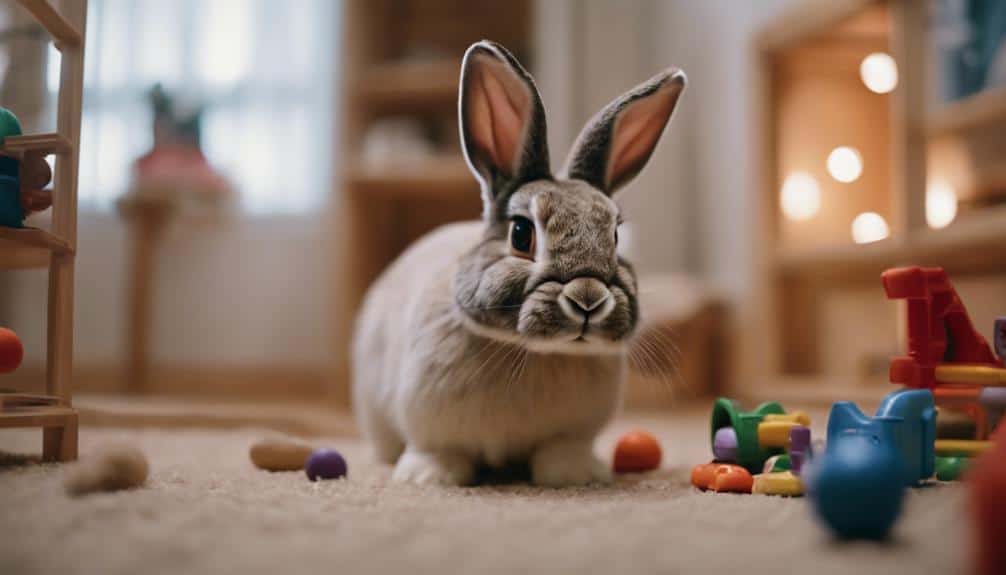
Consistent training, reinforced by positive reinforcement and redirection, effectively prevents your rabbit from digging in unwanted areas. Establish clear boundaries and consistently enforce them to deter digging behavior. Training your rabbit requires patience and repetition, but it’s an investment that pays off in the long run.
Essential training is important. Reward your rabbit with treats or affection when it digs in designated areas. This encourages the desired behavior and helps establish a positive association with appropriate digging spots. Equally important is redirection. When your rabbit starts to dig in a prohibited area, gently guide it to a suitable location.
Supervision during playtime is vital. By closely monitoring your rabbit, you can promptly correct any attempts to dig in inappropriate areas. This ensures that bad habits don’t form and reinforces your training efforts.
Consider these evidence-based strategies for effective training:
- Use treats: Rewarding your rabbit with treats when it digs in the right places.
- Redirection techniques: Gently guiding your rabbit to appropriate digging spots.
- Consistent boundaries: Enforcing clear limits on where digging is allowed.
- Supervised playtime: Closely monitoring your rabbit to prevent unwanted digging.
Rabbit-Proofing Home
To effectively manage your rabbit’s digging behavior, rabbit-proofing your home is a critical step that complements consistent training and supervision. Rabbits dig naturally, and without proper precautions, they can cause significant damage. The goal is to modify their environment to minimize digging opportunities and protect your belongings.
Start by placing plexiglass or plastic floor mats in areas prone to digging. These materials are durable and can withstand persistent digging habits. Additionally, covering your furniture with heavy throws or blankets acts as a barrier against sharp claws.
Creating a designated space for your rabbit is essential. Limiting their access to specific areas early on helps them understand boundaries. Strategically blocking off favored digging spots with furniture can also reduce the likelihood of unwanted behavior. By thoroughly rabbit-proofing a specific space, you mitigate the risk of damage and encourage better habits.
Here’s a quick reference table to help you organize your rabbit-proofing efforts:
| Area | Strategy | Benefits |
|---|---|---|
| Floors | Plexiglass/plastic floor mats | Durable protection |
| Furniture | Heavy throws/blankets | Barrier against claws |
| Designated Space | Limited access | Boundary training |
| Favorite Spots | Move furniture strategically | Reduce digging opportunities |
| Specific Space | Thorough rabbit-proofing | Minimize damage, encourage habits |
Implementing these strategies guarantees your rabbit’s digging behavior is managed, preserving both freedom and property integrity.
Dealing With Persistent Digging
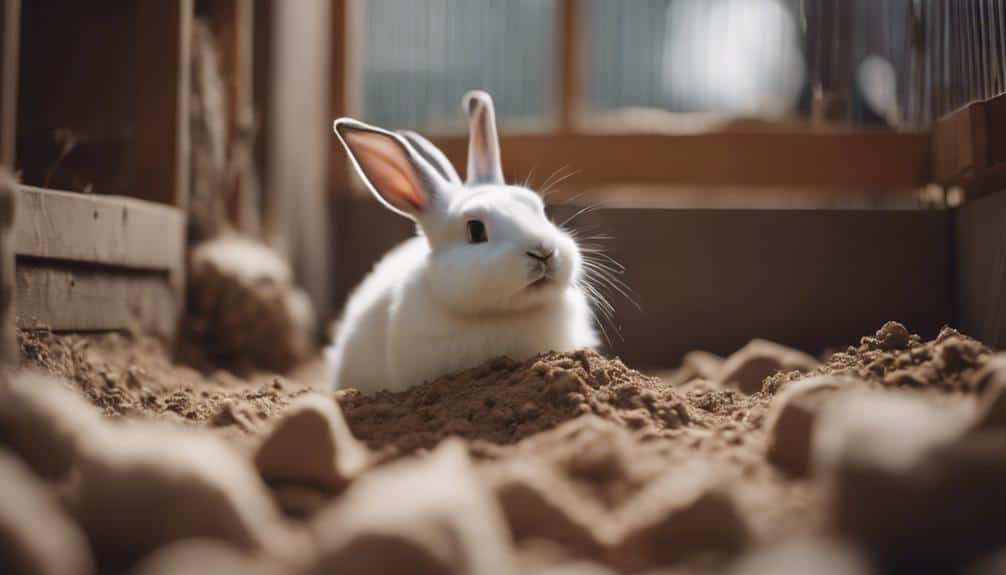
Addressing persistent digging in rabbits involves understanding their natural instincts and providing appropriate outlets to channel this behavior. Digging is a natural habit rooted in their instinct to create burrows and forage for food. To mitigate this behavior, you should create an environment that satisfies these instincts without causing damage to your home.
Implement digging boxes filled with hay, soil, or shredded paper. These boxes provide a designated area where your rabbit can dig freely, satisfying their need to burrow. Supervise your rabbit during playtime and consistently redirect digging behavior to these designated areas. This helps prevent damage to carpets and furniture.
Consistent training is essential. Use positive reinforcement to encourage your rabbit to dig in appropriate locations. Patience is vital, as changing habitual behavior takes time. Additionally, consider spaying or neutering your rabbit. This can reduce hormonal behaviors, including excessive digging, and improve overall behavior.
Here are key strategies to manage persistent digging:
- Provide digging boxes filled with appropriate materials.
- Supervise and redirect digging behavior.
- Use positive reinforcement consistently.
- Consider spaying or neutering to reduce hormonal behaviors.
Benefits of Proper Digging
Allowing your rabbit to engage in proper digging behavior encourages natural instincts and provides essential mental stimulation.
This activity helps reduce destructive habits by offering a suitable outlet for their energy.
Ensuring they’ve designated digging areas can balance their need for burrowing with minimizing escape attempts.
Encourages Natural Behavior
Did you know that proper digging behavior in rabbits not only promotes their physical and mental stimulation but also fulfills their instinctive needs? Encouraging your rabbit to dig in designated areas can make a significant difference in their overall health and happiness.
Digging and chewing are natural behaviors for rabbits and provide essential benefits that shouldn’t be overlooked. Providing appropriate outlets for digging can lead to a more content and less destructive rabbit. When rabbits have suitable places to dig, they’re less likely to engage in unwanted behaviors that might require constant attention from their owners.
Here are some key benefits of encouraging proper digging behavior:
- Nail Maintenance: Digging helps rabbits keep their nails worn down naturally, preventing overgrowth and associated health issues.
- Instinct Satisfaction: Offering designated digging areas satisfies a rabbit’s instinctive need to dig, reducing stress and promoting well-being.
- Environmental Enrichment: Digging allows rabbits to create cozy sleeping spots and hiding places, enhancing their environment.
- Behavioral Health: Providing digging boxes filled with suitable substrates can reduce destructive behaviors, leading to a more harmonious home environment.
Provides Mental Stimulation
Proper digging behaviors in rabbits are essential for providing the mental stimulation they need to thrive. When your rabbit engages in digging, it taps into its natural instincts, mimicking behaviors that are important for its mental and physical well-being. This activity isn’t just about physical exertion; it’s a thorough mental workout that alleviates boredom and keeps your pet alert and engaged.
By allowing your rabbit to dig, you’re offering an outlet for its innate behaviors, which greatly reduces stress and frustration. Rabbits have an instinctive need for exploration and activity, and digging provides the perfect opportunity to fulfill this need. This mental stimulation is crucial for preventing the onset of behavioral issues that arise from a lack of engagement.
Moreover, digging enhances your rabbit’s quality of life by promoting a sense of accomplishment and satisfaction. When rabbits are mentally stimulated, they exhibit fewer signs of anxiety and depression, contributing to overall happier, healthier lives.
Providing appropriate digging opportunities ensures your pet can explore and engage in activities that are both mentally enriching and inherently fulfilling. In this way, proper digging behaviors are indispensable for a rabbit’s mental stimulation and well-being.
Reduces Destructive Habits
Designating specific digging areas for your rabbit greatly reduces destructive behaviors like carpet digging and furniture damage. By providing a designated digging box, you address your rabbit’s instinctual need to dig, leading to a more harmonious household. Evidence suggests that creating appropriate outlets for digging can markedly mitigate unwanted behaviors.
To optimize the benefits of proper digging, consider the following strategies:
- Implement structured training: Guide your rabbit to use designated digging areas through consistent reinforcement.
- Choose the right box: A sturdy, spacious box filled with safe materials like shredded paper or hay can serve as an ideal digging site.
- Monitor and redirect behavior: Observe your rabbit’s habits and gently redirect them to the approved area when they start digging elsewhere.
- Enrich the environment: Incorporate varied digging materials and toys to keep your rabbit engaged and prevent boredom.
Effective training and environmental enrichment not only reduce destructive habits but also foster a strong bond between you and your pet. By addressing your rabbit’s natural behaviors in a controlled manner, you promote their mental and physical well-being while preserving the integrity of your home. This approach underscores the importance of understanding and accommodating your rabbit’s instincts for a happier, healthier pet.
Conclusion
By understanding your rabbit’s natural instincts and providing appropriate outlets like digging boxes, enrichment toys, and safe spaces, you can effectively manage and redirect their digging behaviors.
Consistent training, supervision, and reinforcement of positive actions are essential. Rabbit-proofing your home and addressing persistent issues promptly will further guarantee your rabbit’s well-being.
Implementing these evidence-based strategies fosters a healthy, stimulating environment, ultimately preventing destructive digging and enhancing your pet’s overall quality of life.

